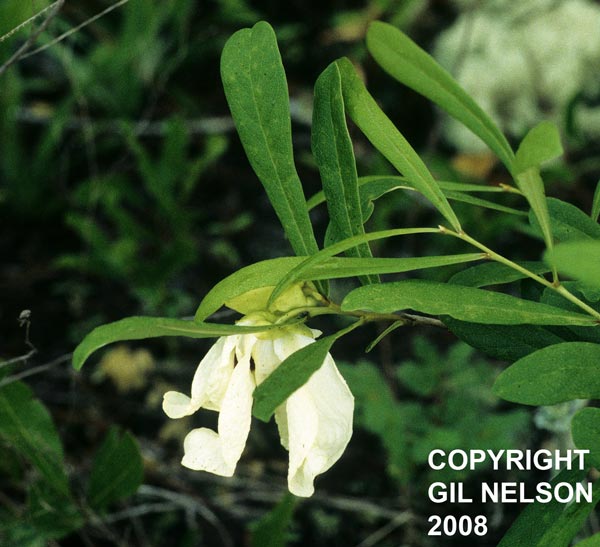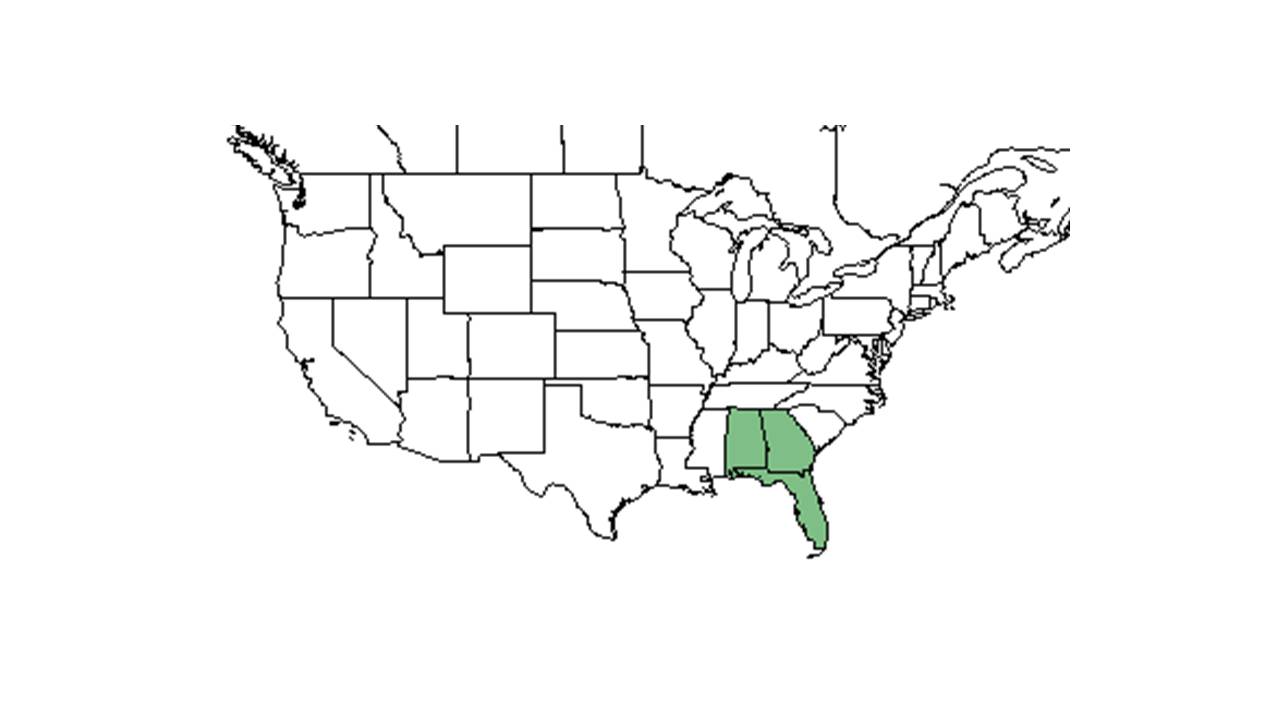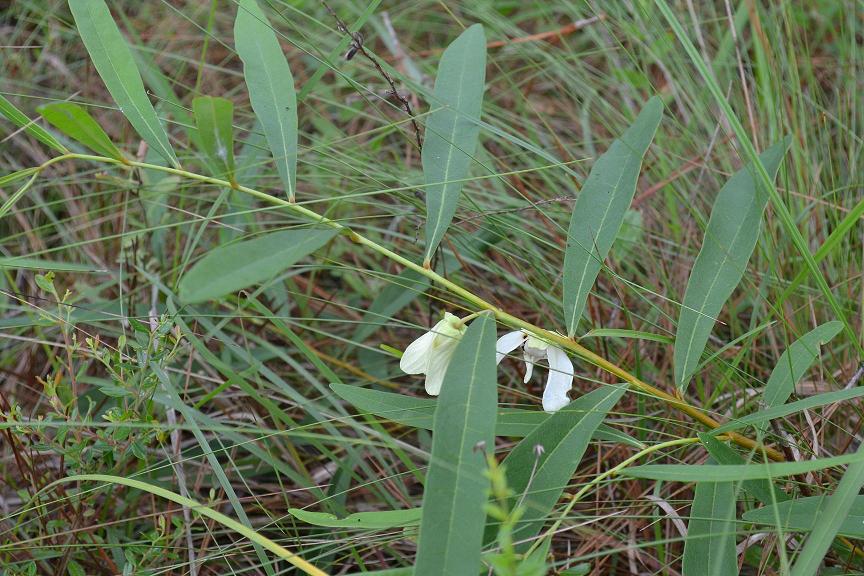Difference between revisions of "Asimina angustifolia"
KatieMccoy (talk | contribs) (→Distribution) |
KatieMccoy (talk | contribs) |
||
| Line 29: | Line 29: | ||
==Ecology== | ==Ecology== | ||
===Habitat===<!--Natural communities, human disturbed habitats, topography, hydrology, soils, light, fire regime requirements for removal of competition, etc.--> | ===Habitat===<!--Natural communities, human disturbed habitats, topography, hydrology, soils, light, fire regime requirements for removal of competition, etc.--> | ||
| − | + | Habitats include dry, well drained pinelands<ref name="weakley">Weakley, Alan S. Flora of the Southern and Mid-Atlantic States: Working Draft of 21 May 2015. University of North Carolina Herbarium (NCU). PDF. 134.</ref> and sandhills, flatwoods, and scrub habitats in partial shade<ref name="wunderlin">Wunderlin, Richard P. and Bruce F. Hansen. Guide to the Vascular Plants of Florida. Third edition. 2011. University Press of Florida: Gainesville/Tallahassee/Tampa/Boca Raton/Pensacola/Orlando/Miami/Jacksonville/Ft. Myers. 258. Print.</ref><ref name="fsu">Florida State University Robert K. Godfrey Herbarium database. URL: http://herbarium.bio.fsu.edu. Last accessed: June 2014. Collectors: L. C. Anderson, R. K. Godfrey, R. Komarek, A. Schmidt, and Robert S. Blaisdell. States and Counties: Florida: Gadsden, Lafayette, Leon, and Wakulla. Georgia: Baker and Thomas.</ref>. Specifically it is found in frequently burned longleaf pine-wiregrass uplands (Ultisols) and longleaf wiregrass sandhills (Entisols) in north Florida and southern Georgia. ''Asimina angustifolia'' is predominately in the native groundcover with a statistical affinity in upland pinelands of South Georgia<ref name="ostertag">Ostertag, T.E., and K.M. Robertson. 2007. A comparison of native versus old-field vegetation in upland pinelands managed with frequent fire, South Georgia, USA. Pages 109–120 in R.E. Masters and K.E.M. Galley (eds.). Proceedings of the 23rd Tall Timbers Fire Ecology Conference: Fire in Grassland and Shrubland Ecosystems.</ref>. This species has also been found to be growing along roadsides<ref name="fsu"/>. | |
| − | |||
| − | Associated species includes ''Phlox floridana, Stillingia sylvatica, Lactuca graminifolia, Stylosanthes biflora, Erigeron strigosa, Baptisia lanceolata, Hedyotis crassifolia, Pterocauloon undulatum, Asclepias humistrata, Quercus hemisphaerica'' and other | + | Associated species includes ''Phlox floridana, Stillingia sylvatica, Lactuca graminifolia, Stylosanthes biflora, Erigeron strigosa, Baptisia lanceolata, Hedyotis crassifolia, Pterocauloon undulatum, Asclepias humistrata, Quercus hemisphaerica'' and other<ref name="fsu"/>. |
===Phenology===<!--Timing off flowering, fruiting, seed dispersal, and environmental triggers. Cite PanFlora website if appropriate: http://www.gilnelson.com/PanFlora/ --> | ===Phenology===<!--Timing off flowering, fruiting, seed dispersal, and environmental triggers. Cite PanFlora website if appropriate: http://www.gilnelson.com/PanFlora/ --> | ||
Revision as of 15:21, 31 March 2016
| Asimina angustifolia | |
|---|---|

| |
| photo by Gil Nelson | |
| Scientific classification | |
| Kingdom: | Plantae |
| Division: | Magnoliophyta - Flowering plants |
| Class: | Magnoliopsida - Dicotyledons |
| Order: | Magnoliales |
| Family: | Annonaceae |
| Genus: | Asimina |
| Species: | A. angustifolia |
| Binomial name | |
| Asimina angustifolia Raf. | |

| |
| Natural range of Asimina angustifolia from USDA NRCS Plants Database. | |
Common Name: Slimleaf Pawpaw
Contents
Taxonomic notes
Synonyms: Asimina longifolia Kral var. longifolia; Asimina angustifolia; Pityothamnus angustifolius (Rafinesque) Small
Description
A description of Asimina angustifolia is provided in The Flora of North America.
Distribution
It is found in southeastern Georgia to central peninsular of Florida to the west towards the Suwannee River[1].
Ecology
Habitat
Habitats include dry, well drained pinelands[1] and sandhills, flatwoods, and scrub habitats in partial shade[2][3]. Specifically it is found in frequently burned longleaf pine-wiregrass uplands (Ultisols) and longleaf wiregrass sandhills (Entisols) in north Florida and southern Georgia. Asimina angustifolia is predominately in the native groundcover with a statistical affinity in upland pinelands of South Georgia[4]. This species has also been found to be growing along roadsides[3].
Associated species includes Phlox floridana, Stillingia sylvatica, Lactuca graminifolia, Stylosanthes biflora, Erigeron strigosa, Baptisia lanceolata, Hedyotis crassifolia, Pterocauloon undulatum, Asclepias humistrata, Quercus hemisphaerica and other[3].
Phenology
It flowers from spring to summer (Wunderlin and Hansen 2011).
Kevin Robertson has observed this species flower within three months of burning. KMR
Fire ecology
This species has been seen in burned and fire excluded areas (FSU Herbarium). Resprouts and flowers within two months of burning. KMR
Conservation and Management
It requires frequent fire and protection from soil disturbance.
Cultivation and restoration
Photo Gallery
References and notes
Florida State University Robert K. Godfrey Herbarium database. URL: http://herbarium.bio.fsu.edu. Last accessed: June 2014. Collectors: L. C. Anderson, R. K. Godfrey, R. Komarek, A. Schmidt, and Robert S. Blaisdell. States and Counties: Florida: Gadsden, Lafayette, Leon, and Wakulla. Georgia: Baker and Thomas.
Ostertag, T.E., and K.M. Robertson. 2007. A comparison of native versus old-field vegetation in upland pinelands managed with frequent fire, South Georgia, USA. Pages 109–120 in R.E. Masters and K.E.M. Galley (eds.). Proceedings of the 23rd Tall Timbers Fire Ecology Conference: Fire in Grassland and Shrubland Ecosystems.
Weakley, Alan S. Flora of the Southern and Mid-Atlantic States: Working Draft of 21 May 2015. University of North Carolina Herbarium (NCU). PDF. 134.
Wunderlin, Richard P. and Bruce F. Hansen. Guide to the Vascular Plants of Florida. Third edition. 2011. University Press of Florida: Gainesville/Tallahassee/Tampa/Boca Raton/Pensacola/Orlando/Miami/Jacksonville/Ft. Myers. 258. Print.
- ↑ 1.0 1.1 Weakley, Alan S. Flora of the Southern and Mid-Atlantic States: Working Draft of 21 May 2015. University of North Carolina Herbarium (NCU). PDF. 134.
- ↑ Wunderlin, Richard P. and Bruce F. Hansen. Guide to the Vascular Plants of Florida. Third edition. 2011. University Press of Florida: Gainesville/Tallahassee/Tampa/Boca Raton/Pensacola/Orlando/Miami/Jacksonville/Ft. Myers. 258. Print.
- ↑ 3.0 3.1 3.2 Florida State University Robert K. Godfrey Herbarium database. URL: http://herbarium.bio.fsu.edu. Last accessed: June 2014. Collectors: L. C. Anderson, R. K. Godfrey, R. Komarek, A. Schmidt, and Robert S. Blaisdell. States and Counties: Florida: Gadsden, Lafayette, Leon, and Wakulla. Georgia: Baker and Thomas.
- ↑ Ostertag, T.E., and K.M. Robertson. 2007. A comparison of native versus old-field vegetation in upland pinelands managed with frequent fire, South Georgia, USA. Pages 109–120 in R.E. Masters and K.E.M. Galley (eds.). Proceedings of the 23rd Tall Timbers Fire Ecology Conference: Fire in Grassland and Shrubland Ecosystems.
